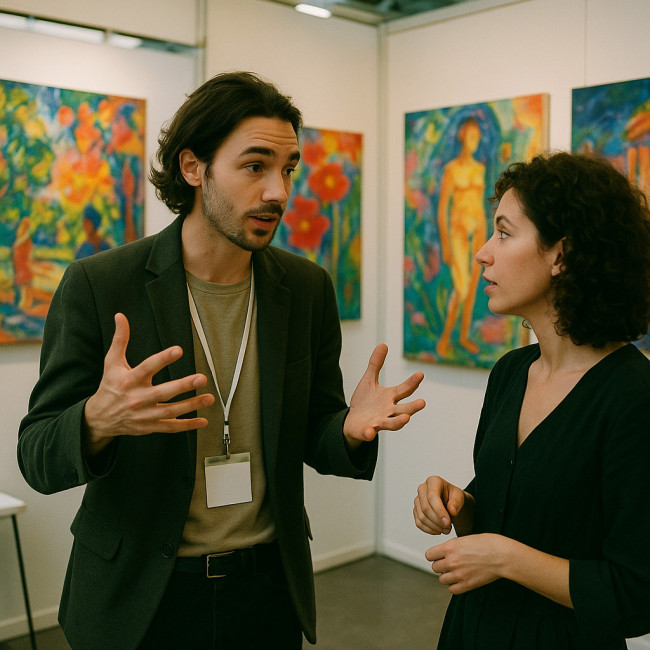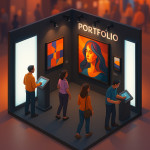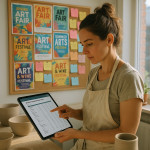Networking at art fairs: tactics to turn quick chats into lasting partnerships
Art fairs compress a year's worth of gallery visits and studio tours into a single weekend. When you master networking at art fairs, those whirlwind conversations can evolve into collaborations, exhibitions and steady sales. This guide walks you through the before-during-after playbook to transform informal chats into partnerships that fuel your creative career.
Why networking at art fairs still dominates the deal flow

Dealers attributed 35 % of their 2022 turnover to art-fair sales, up from 27 % in 2021 according to the latest Art Basel & UBS Art Market Report. Even as online platforms soar, face-to-face rapport builds trust faster than any feed scroll. Effective fair networking therefore remains a pillar alongside online tactics such as an optimised photography event calendar or targeted directory ads.
Before the fair: lay indestructible groundwork
Set a single partnership goal
Choose one clear outcome—gallery representation, brand collaboration or collector introductions. A focused objective drives sharper conversations than a vague “meet everyone” approach.
Research and rank targets
Download the exhibitor list, then score each stand on relevance and growth potential. Map a walking route that mirrors your ranking so you stay fresh for the most strategic chats. Creatives such as sculptors use a similar tactic at design weeks; see our networking tips for sculptors for a detailed floor-plan template.
Craft a 20-second micro-pitch
Your micro-pitch must state the medium, signature style and benefit. Example: “I'm a textile artist weaving phosphorescent fibres into wall tapestries that double as mood lighting—galleries tell me it keeps visitors lingering longer.” Practise until it sounds conversational, not canned.
Prep friction-free shareables
- QR code linking to a mobile portfolio.
- A five-image digital lookbook under 3 MB.
- An NFC card to swap details with one tap.
During the fair: turn quick chats into qualified leads

Whether you drop into Art Basel Miami Beach or a regional photography salon, the sensory overload can be staggering: layered conversations mix with the thrum of portable card readers, fluorescent spots bounce off lacquered frames, and collectors zig-zag from monumental neon sculptures to delicate daguerreotypes. Pausing for a single mindful breath helps you reset your posture, notice traffic rhythms and enter exchanges at precisely the right moment. Observing cadence first prevents you from barging into a price negotiation mid-sentence and gifts you fresh talking points drawn from the stand's immediate context. By treating the fair floor like a living mood board, you harvest conversational hooks—material choices, framing innovations, display lighting—that make your pitch feel natural rather than rehearsed, dramatically increasing your chance of securing a qualified lead.
Lead with curiosity
Approach stands by asking about a specific artwork or curatorial choice. The dealer feels valued, and you gather context to position your practice.
Mirror language and energy
If a curator speaks in concise bullet points, match the rhythm. If they wax poetic, respond with narrative. Mirroring fosters subconscious trust.
Deploy the “listen-link-leap” method
- Listen for challenges—shipping large pieces, sourcing new media, diversifying audiences.
- Link your value proposition to one of those pain points.
- Leap to a micro-commitment: “May I send you a two-minute video that shows our lightweight framing solution?”
Capture context, not just contacts
Write a three-line memo on each chat: who, pain point, promised next step. Apps like Airtable or even voice notes work. This context will power personalised follow-ups that outshine generic thank-you emails.
Balance new and existing ties
Allocate 70 % of time to new prospects and 30 % to nurturing current allies. Your existing network may introduce you on the spot, accelerating trust—similar to tactics described in our networking mixers article.
Use tech for instant reciprocity
Show a relevant project on your tablet while scanning their badge to auto-populate a CRM entry. Immediate value plus captured data equals a warmer lead.
After the fair: engineer lasting partnerships

Post-fair momentum evaporates when creatives treat follow-up as an afterthought. Block out a two-hour slot in your calendar before the event even begins so that, once home, you can sit down with espresso and noise-canceling headphones to convert every business card and voice note into actionable next steps. Rewrite your three-line memos into concise but vivid proposals, attach images that mirror each prospect's aesthetic, and log commitments directly into your CRM. By batching this work while impressions remain fresh, you avoid the common trap of sending lukewarm emails weeks later and instead deliver razor-focused value that reminds curators why they were excited about your practice. This discipline turns a chaotic pile of leads into a steadily advancing pipeline rather than a digital graveyard of missed opportunities.
0-day follow-up
Send a personalised message the same evening. Reference the exact artwork you discussed and attach the promised asset. Quick action signals reliability—a trait curators prize.
7-day nurture sequence
- Day 3: share a behind-the-scenes photo that elaborates on your process.
- Day 5: forward a press article in which their gallery is mentioned, adding thoughtful commentary.
- Day 7: propose a low-barrier next step—virtual studio tour, coffee during another upcoming fair, or co-writing a grant.
Create a shared win
Partnerships outlast sales when both sides profit. Offer exclusive edition rights or cross-promotion via artvertising event strategies that amplify their booth traffic at the next fair.
Track momentum with a simple funnel
| Stage | Goal | Key metric |
|---|---|---|
| Initial chat | Obtain permission to follow up | % contacts agreeing to receive material |
| Qualified lead | Schedule meeting/studio visit | Calendar bookings |
| Proposal | Submit collaboration outline | Proposals sent |
| Partnership | Signed agreement | Contracts closed |
Use peer accountability
Share progress with a trusted colleague weekly. This simple ritual, borrowed from a trade-fair networking guide, keeps you moving deals forward instead of letting leads decay in your inbox.
Networking at art fairs Quiz: are you fair-ready?
FAQ
- How many new contacts should I aim for at a mid-size fair?
- Quality beats volume. Target 15–20 meaningful conversations that align with your partnership goal.
- Is it acceptable to show work on a phone?
- Yes, if images load instantly and brightness is high. A tablet, however, offers more impact without feeling intrusive.
- What if the stand is crowded?
- Return during quieter hours—usually the last 90 minutes of each day—or compliment the gallerist's success and book a follow-up instead of forcing a rushed chat.
- Should I bring physical leave-behinds?
- Lightweight postcards can help but keep them optional. Many dealers now prefer digital materials to reduce carry-on weight.
Ready to turn your next fair into a partnership factory?
Implement one tactic from each section at your upcoming event and track the results. When you feel confident, level up by studying how photographers network effectively at photo fairs. Consistent refinement will stack small wins into major career leaps.
Call to action: Schedule a 15-minute strategy call with our community coaches and receive a checklist tailored to your next fair.











